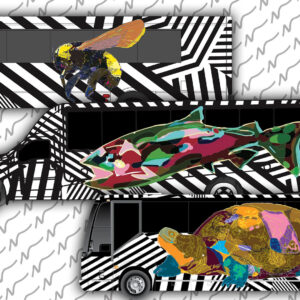A must read for nature lovers: "Where the Wild Things Were" by William Stolzenburg
Have wily coyotes been frequenting a forest, field, town or neighbourhood near you recently? [Probably]
Have you heard of a fur-bearing critter called a fisher, the meso-carnivore possibly behind disappearing domestic cats in some rural areas? [Maybe]
Have you heard the haunting howl of a wolf echoing through the streets of your neighbourhood? [Almost no chance if you live in a populated area]
– o – o – o – o –
Yes, there are ‘wild things’ among us. And yes, a few of them are ‘predators’ by definition. This is nothing new, nor should it come as any surprise. What is surprising, however, is the cast of wild characters that currently populates parts of North America compared to what used to be there…
 We’ve all heard accounts of the packs of wolves or solitary big cats that once roamed the wildlands of our continent. They hunted their prey in relative isolation from human populations; that is, until we encroached on almost all their habitats and forced them into increasingly smaller fragments of ‘wilderness’. Now we more commonly associate species such as lynx, red and grey wolf and eastern cougar with regional – or even national – lists of species at risk. And those wildlands? Well, they’re something we usually drive far from towns or cities to see in “nature’s museums”, aka, strictly protected areas like national parks.
We’ve all heard accounts of the packs of wolves or solitary big cats that once roamed the wildlands of our continent. They hunted their prey in relative isolation from human populations; that is, until we encroached on almost all their habitats and forced them into increasingly smaller fragments of ‘wilderness’. Now we more commonly associate species such as lynx, red and grey wolf and eastern cougar with regional – or even national – lists of species at risk. And those wildlands? Well, they’re something we usually drive far from towns or cities to see in “nature’s museums”, aka, strictly protected areas like national parks.
William Stolzenburg, formerly a writer for The Nature Conservancy and Science News, masterfully describes the fate of North America’s former top predators in his fantastic book, “Where The Wild Things Were: Life, Death, and Ecological Wreckage in a Land of Vanishing Predators” (published by Bloomsbury). To support his narrative, Stolzenburg peers into the minds and experiences of the scientists behind some of the key findings that have arisen from the “ecological wreckage”. He interweaves the seminal work of ecologists including Michael Soulé, John Terborgh, Robert T. Paine, James A. Estes, David S. Wilcove, William J. Ripple, Robert L. Beschta, and Aldo Leopold, on the pivotal roles of top predators in nature – and the ecological meltdown that’s taking place on land and in the sea in their absence.
Deftly citing research from the scientists listed above (and many others), Stolzenburg walks the reader through several studies of “trophic cascading” which, simply put, is the falling apart of a food web that occurs when there are few or no top predators to effectively regulate prey populations. Prey species may then over-browse entire ecosystems, decreasing habitat quality and the food available for other species. New predators and prey may invade these systems over time, exerting new ecological pressures on the biotic community. Soon an ecosystem or biological community that was once thriving may be diminished to one that is a ghost of its former self, inhabited by opportunistic species (think of white-tailed deer, coyotes and Barred Owls) that were historically never common – or not even present at all. One could go on…
Instead, I heartily invite you to read Stolzenburg’s book. You will not be disappointed. As a conservation biologist and a fervent enthusiast for natural areas, I found his writing incredibly refreshing and thought-provoking. Stolzenburg is by all means a very accessible writer, too. I also appreciated his keen interest in this topic, which comes through clearly in his prose. He paints a cunning picture of white-tailed deer population irruptions throughout the United States, and solidly sleuths the full story behind the importance of wolves to Yellowstone National Park’s biological community.
This book now holds a special place on my shelf, next to books like Monster of God: The Man-Eating Predator in the Jungles of History and the Mind (David Quammen), One River & Shadows in the Sun (Wade Davis), Ishmael (Daniel Quinn) and Let the Mountains Talk, Let the Rivers Run (David Brower). It is truly a must-read that, unfortunately, had to be written; it shows us how blindly we persecute some wild animals without understanding their important roles in maintaining nature’s balance.
“And I can only believe, from somewhere deeper than any logic center of the brain, that a life of incomprehensible loneliness awaits a world where the wild things were, but are never again.”
– William Stolzenburg, 2008, from “Epilogue”, Where The Wild Things Were, p.218 (Bloombury USA)





